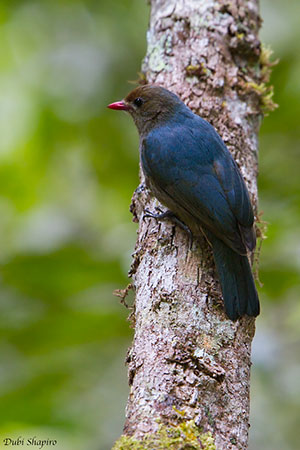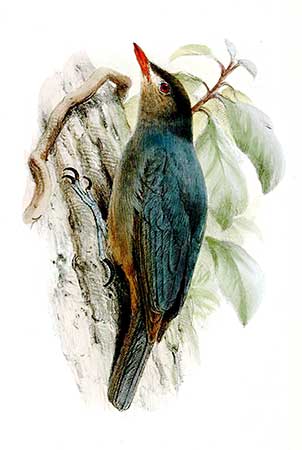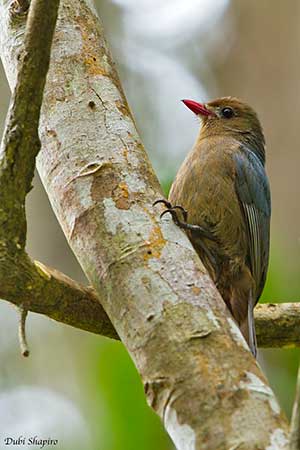
Nothing is known of the breeding behaviour of this species. The nest materials include a large amount of moss found in the humid rainforest, and reflect the habitat of the species. These materials are different from those utilized by other Vangidae which commonly add cobweb to the nest structure.
The Nuthatch Vanga is probably sedentary on the island.
The flight is undulating while the bird flies between trees.
REPRODUCTION OF THIS SPECIES:
The breeding season probably occurs in August-September, with a nest found in October.
The Nuthatch Vanga collects piles of moss and places them in a hollow in tree trunk, attached to the main trunk. The nest is cup-shaped. No other information.
PROTECTION / THREATS / STATUS:
The Nuthatch Vanga has restricted range in Madagascar. It is fairly common in N and rather rare in S. The species occurs in several protected areas, reserves and national parks, but it depends on rainforest.
The Nuthatch Vanga is not globally threatened and currently evaluated as Least Concern.
Fr: Hypositte malgache
Ang: Nuthatch Vanga
All: Korallenschnabelvanga
Esp: Vanga Trepador
Ita: Vanga sitta
Nd: Boomklevervanga
Sd: klättervanga
Mal: bolokikely, Sakodidy, Voronakodidina
Photographer:
Dubi Shapiro
Dubi Shapiro Photo Galleries & Dubi Shapiro's Pictures on IBC
Illustrator:
Joseph Wolf (1820-1899)
Origin of illustration
Sources:
HANDBOOK OF THE BIRDS OF THE WORLD Vol 14 by Josep del Hoyo-Andrew Elliot-David Christie - Lynx Edicions – ISBN: 9788496553507
Wildlife of Madagascar par Ken Behrens,Keith Barnes - ISBN: 140088067X, 9781400880676 – Editeur: Princeton University Press, 2016
Birds of Madagascar: A Photographic Guide Par Pete Morris, Frank Hawkins – ISBN: 0300077556, 9780300077551- Editeur: Yale University Press, 1998
Birds of the Indian Ocean Islands Par Ian Sinclair, Olivier Langrand - ISBN: 1868729567, 9781868729562- Editeur: Struik, 2003
The Birds of Africa: Volume VIII: The Malagasy Region: Madagascar, Seychelles, Comoros, Mascarenes - Par Roger Safford, Frank Hawkins – ISBN: 1408190494, 9781408190494- Editeur: A&C Black, 2013
Creagus – Bird Families of the World – Vangas - Vanginae
THE VANGAS OF MADAGASCAR by Nick Garbutt
Vanga - From Wikipedia, the free encyclopedia
Key Environments: Madagascar publié par A. Jolly,P. Oberle,R. Albignac
Tits, Nuthatches and Treecreepers Par Simon Harrap
Home page
Page Order Passeriformes
Nuthatch Vanga
Hypositta corallirostris
Passeriformes Order – Vangidae Family
INTRODUCTION:
The Nuthatch Vanga, formerly named Coral-billed Nuthatch, is endemic to Madagascar. It occurs in the primary evergreen humid forest, usually below 1,000 metres of elevation in E Madagascar.
Its foraging behaviour by climbing tree trunks is very similar to the nuthatches of genus Sitta. However, unlike the true nuthatches, it only climbs upwards, and never sideways or downwards. From DNA analysis and comparisons, the Nuthatch Vanga is extremely distantly related to nuthatches.
This unusual little vanga could have evolved to fill the niche of nuthatches and woodpeckers, both absent from the island.
The Nuthatch Vanga is not globally threatened, but it has restricted range. It is described as locally common, and it is present in several protected areas.

RANGE:
The Nuthatch Vanga is found in N and E Madagascar, S to Tôlanaro.
HABITAT:
The Nuthatch Vanga frequents lowland primary evergreen humid forest, usually below 1,000 metres, but the species is recorded from sea-level to 1,800 metres of elevation.
CALLS AND SONGS: SOUNDS BY XENO-CANTO
The Nuthatch Vanga utters short, very high-pitched trill. The contact call is a faint “tseep-tseep”. We can also hear series including quiet hissing and squeaking notes.
Some intonations may recall those of the Eurasian Nuthatch (Sitta Europaea), but they are quieter.
BEHAVIOUR IN THE WILD:
The Nuthatch Vanga feeds on invertebrates including insects (Coleoptera, Blattodea and some others). It also takes worms and small vertebrates.
It forages from mid to upper canopy, rarely at lower levels. It forages by climbing up and along tree trunks and branches in jerky motion. It climbs upwards and forwards, but unlike the nuthatches, it does not move sideways or downwards.
The Malagasy name of this species “Voronakodidina” means “bird turning and climbing around the tree”.
The Nuthatch Vanga is often seen in pairs or small groups within mixed-species flocks, with other vanga species and various passerines. It can be aggressive towards other members of its species, and chases often occur.

DESCRIPTION OF THE BIRD:
Biometrics:
Length: 13-14 cm
Weight: 13,5-14,5 g
The Nuthatch Vanga is the smallest members of the family Vangidae.
The adult male has mid-blue plumage overall, except a variable pale buff area on vent.
On the head, lower forehead, lores and chin are black, contrasting with the coral-red bill. The eyes are blackish-brown. Legs and feet are dark grey. The claw of the first toe is elongated (2 cm) and allows the bird to creep up tree trunks while foraging.
The female (displayed) has blue upperparts, but unlike the male, she has brownish-green head, without black markings, buffy forecrown and buffish rump.
On the underparts, chin, centre of breast and belly are buffish. The red bill is duller than in male.
The juvenile resembles female, but the young male has increasing amounts of blue on head and breast sides with age.
